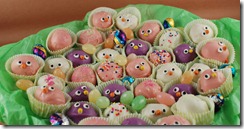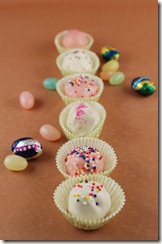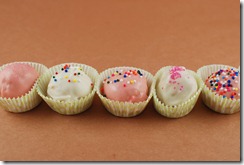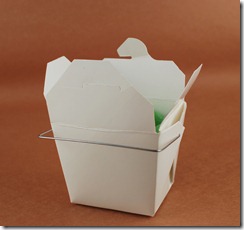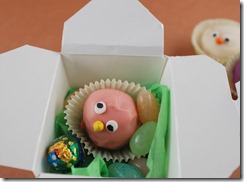Home » Archives for Maret 2010
Another Dose of Cancer Killers on Board!
Diposting oleh good reading on Rabu, 31 Maret 2010
EASTER CHICK CAKE BALLS
Diposting oleh good reading on Selasa, 30 Maret 2010
Here’s a cute treat to make for kiddie Easter parties and will totally please adults too!
These were so fun to make! The googly eyes, beaks and feet are simply glued on with white candy melts. I used Wilton candy sprinkles: the feet are orange maple leaves; the beaks are orange or yellow coloured sprinkles the shape of mini-chips and the eyes are white confetti sprinkles coloured with a black food writer pen.
I just happened to be at Safeway today and spied a sale on cake mixes and frostings. I picked up 3 boxes for $5 and the cream cheese frosting in the can was only $1.29
I think the quickest way to bake off the mix is to make cupcakes. That way my kids get to eat the leftovers too. For every 8 large cupcakes, I used approximately 2-3 tablespoons of the prepared cream cheese frosting.
After baking the cupcakes, let them cool and then proceed to crumble the cakes in a large bowl. I used a spoon to help it all along. Then add the frosting a tablespoon at a time. Don’t go overboard with the frosting as a little goes a long way. If you put too much, you might have issues with the cake balls setting properly (especially if you want them on sticks).
This time, I chose not to employ sticks for my chicks. Instead, I made truffle balls and refrigerated them on a sheet pan.
I melted one colour at a time so as not to encounter problems with the candy melts cooling down too quickly. Do add a little bit of shortening to the candy melts after you melt them. Stir it in until the mixture is fluid. It’ll help prolong the workability of the melted candy.
You should have all your sprinkles prepared in little custard cups. I like to melt my candy melts in custard cups in the microwave in 20 second increments. Add a bit of the shortening after the candy has melted.
As soon as you dunk your cake ball into the melted candy, turn it around (use chopsticks or a mini rubber spoontula) quickly and then place it on a parchment-lined sheet pan. Do not refrigerate your cake balls or they’ll sweat.
If you want sprinkles, add them while the candy is still wet.
I like to leave the chicks for last. They don’t need to have sprinkles on them while they’re wet. It’s way easier applying their faces after they’ve dried.
If you would like to add feet to your chicks, I find that mini maple leaf sprinkles are the best. Just use a little of the leftover candy melts to dab the sprinkles. I use a toothpick and I imagine if you need, you can use a clean pair of tweezers to place them on the cake balls.
I found some cute green pastel mini cupcake paper liners at Superstore and placed my dried cake balls in them. The definitely look better in their individual “nests”. You can fussy them up too by packaging them in cellophane bags, baskets or chinese take-out containers.
I’m partial to the lavender chicks. They were made with the lavender candy melts. You don’t have to worry about using food colouring because the melts come in a whole bunch of colours.
This chick is my favourite. What an expression! He’s so sweet-looking!
As you’re making the faces, you’ll come to see that each chick has its own personality. The placement of the eyes and beaks can create such cute faces.
Here’s one of the mini Chinese take-out containers I like to use. I stuff them with green tissue paper, drop in a handfull of jellybeans and a few foil-covered chocolate eggs and place the little Easter Chick Cake Ball in the centre.
We’re sending this guy to Bebe’s teacher tomorrow morning…
The lavender chick is for Bebe’s piano teacher…
Do make these little chicks.
They’re so easy to make and the fun factor is huge!
Shopping list for: EASTER CHICK CAKE BALLS
- 1 box prepared cake mix (I used yellow cake)
- 1 can prepared frosting (I used Cream Cheese frosting)
- Assorted Wilton Candy melts in your favourite colours
- Sprinkles, dragees and a black food writer pen
Last year I made Easter Brownie Bunny Pops. Check it out!
And my Brownie Chicks on a Stick are cute too!
UNAPOLOGETIC CHOCOLATE CHUNK COOKIES
Diposting oleh good reading on Senin, 29 Maret 2010
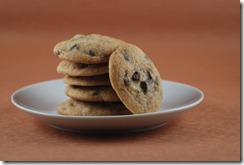
Have you ever wanted to just have a plain old chocolate chip cookie that hasn’t been mussed with or fussed with—and wanted it now? Right now?
That day came. Today.
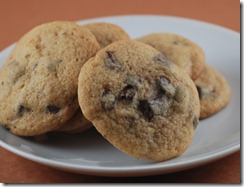
I wanted a chocolate chip cookie that reminded me of youth-- when I’d sit in front of Scooby Doo on the tube after school with a glass of WHOLE milk and a plate of cookies on my saucer that I’d take a bite of just so…so I could fit it into my milk glass and dunk it. And the cookie would saturate with milk and it would yield gently in my mouth, dissolving into sweet crumbly bliss. The chocolate chips tasted of blackness and I’d chug the glass until I’d spy the sandy chunks of lost cookie bits trailing with the wave of white. I’d tilt back to let it ride the milk into my mouth.
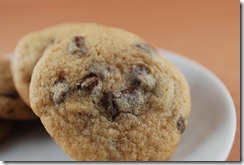
From the myriad chocolate chip cookie recipes and adaptations I’ve tried, I know the Toll House recipe I found on the back of the bag of chocolate chips would yield that taste sensation I was seeking. However, that would be so boring. After all, I do have a duty to try as many of those chocolate chip cookie recipes waiting patiently on my massive bookshelf of cookbooks as I humanly can.
But what book would possibly address my immediate needs? The Barefoot Contessa’s cookbooks have always pleased my palate when I yearned for traditional full-fat unadulterated ingredients and the recipes have always proven to work. I mean, how can you go wrong when you see on the Food Network Ina Garten smiling her smile and unapologetically calling for “a pound of butter” in her recipes? I must say, her life is fetching. Who wouldn’t love to be surrounded by that gorgeous garden and have all those handsome gay hunks dropping by so frequently for dinner parties while her husband is away?

I just love watching her show. She has everything I covet. I want her lovely white kitchen, her fantastic garden and her beautiful house. I even think she has the perfect husband: he loves everything she bakes and eats her food with relish (unlike Stomach who hates sweets and out of sheer kindness sticks out his pinky to indicate the size of the “sliver” of cake he would like to be served).
Sigh.
Life is so unfair.
Hey, I have passion but no at home’s up for ingesting my goodies. People fear the bulge, as do I. They fear the full-fat sugar-laden richness of desserts. As do I. My only recourse is to distribute my real-butter’n-white flour’n sugar cardiac bombs to my colleagues. They are so generous to risk their arteries for me!

They say moderation is key to maintaining a healthy diet. So, I profess that the low-fat versions of cookies will not do! What good will it be when you polish off the whole sheet of cookies and your blasted brain still isn’t fooled? It knows. It hasn’t forgotten the amazing chocolate chip cookie you ate when you were 7 sitting in front of the t.v. watching Scooby Doo.

Thus, with a cautious heart I dare you to make those full-fat cookies and give away 3/4 of them (or more if you have the will-power!) to friends and colleagues to maintain good karma and a lithe figure. It’s the only way to go.
The recipe below was easy to make and quick too. There isn’t any “aging” of the dough or any weird ingredients. There’s absolutely nothing really healthy in it either in the way of added fiber. No oatmeal; no ground flax…and everything’s refined. Oh well. My eggs are always free-range because I have an organic veggie bin delivered every 2 weeks, but that’s a small consolation. I have organic evaporated cane sugar and organic unbleached flour, but heck, that might jeopardize the memory of the 1970’s version of the cookie I was seeking. The result? Good. Very Good. Not like I remembered though. I’m not done going through all those other chocolate chip cookie recipes.
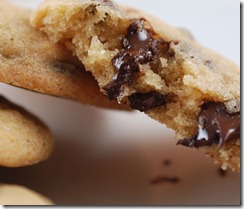
CHOCOLATE CHUNK COOKIES
from Ina Garten’s Barefoot Contessa: Parties!
makes 36-40 cookies
- 1/2 pound unsalted butter at room temperature
- 1 cup light brown sugar, packed
- 1/2 cup granulated sugar
- 2 teaspoons pure vanilla extract
- 2 extra-large eggs at room temperature
- 2 cups all-purpose flour
- 1 teaspoon baking soda
- 1 teaspoon kosher salt
- 1 1/2 cups chopped walnuts (I omitted these as my kids have nut allergies)
- 1 1/4 pounds semisweet chocolate chunks
- Preheat the oven to 350 degreesF.
- Cream the butter and two sugars until light and fluffy in the bowl of an electric mixer fitted with the paddle attachment. Add the vanilla, then the eggs, one at a time, and mix well. Sift together the flour, baking soda, and salt and add to the butter with the mixer on low speed, mixing only until combined. Fold in the walnuts and chocolate chunks.
- Drop the dough on a baking sheet lined with parchment paper, using a 1 3/4-inch diameter ice cream scoop or a rounded tablespoon. Dampen your hands and flatten the dough slightly. Bake for exactly 15 minutes (the cookies will seem underdone). Remove from the oven and let cool slightly on the pan, then transfer to a wire rack to cool completely.
Good Drip
Diposting oleh good reading
Talkin' Bout A Revolution...Jamie Oliver is much louder than a whisper!
Diposting oleh good reading on Sabtu, 27 Maret 2010

So I just finished watching the premiere episode of "Jamie Oliver's Food Revolution". It is a new show on ABC that chronicles the journey of English chef Jamie Oliver as he tries to change the eating habits of residents in Huntington, West Virginia. Huntington was recently crowned the most unhealthy city in America.
It is obvious that Jamie has good intentions. He has left his family for several months to work on this project. He is especially concerned about the quality of food being served in the Huntington schools. However, my reaction to the first episode was "No, no, no! Stop what you're doing and talk to these people first!"
The most important part of any public health intervention is getting to know the community you are working with. The worst thing you can do is come in as an "outsider" and start barking orders. Some questions you should ask before getting started are: How does this community operate? Who makes the decisions? What are some of the barriers to serving fresh food in schools? What are the USDA guidelines? (which Jamie knows nothing about) Who are the individuals you want/need to get on board with your idea? How do the parents feel about their children's eating habits? How can you get their buy-in? What would be a realistic timeline for assessment/buy-in before trying to implement change?
Jamie went about this all backwards (which may very well have been to increase drama for a TV show, but it is still a great example of "what not to do"). His first day in town he was told he was viewed as an "outsider" by the trusted radio host...and still proceeded to go into the elementary school and lecture the chefs on how disgusting the food is (after only observing them for one day). And he's surprised he's getting push back on his efforts?! The only small victory he has is creating a partnership with "Pastor Steve" at the local Baptist church. Steve is a trusted leader in the community and knows the families and their challenges very well.
Too bad Jamie did not look to better models of this kind of community effort. Shape Up Somerville (Somerville, MA) began as a community based research study at Tufts University targeting 1st through 3rd graders in the Somerville Public Schools. Today there is Coordinator working on active and healthy living programs supported by the Health Department and a Taskforce that is a collaboration of over 11 initiatives and 25 stakeholders involved in working on various interventions across the city. Program components include a focus on the school lunch program, local restaurants, walk ability and safe routes to school, etc. (I'll give a shout out here to one of my public health heroes- Julia Bloom- who helped Tufts bring this model to more rural communities across the country!)
Shape Up Somerville represents a strong program that began with a strong base. The original program engaged key stakeholders and did not try to change the community without first finding out how it worked. The community and parent outreach were an obvious key to success...where that aspect is basically forgotten in the "Food Revolution". Jamie just seems like one man on a mission to change. At the end of the episode Jamie is visibly upset and says "they don't know why I'm here". Yeah- that's because you're an outsider lecturing them on how they should raise their kids!
I'll probably watch the second episode where he actually starts to engage the community...how about you?
My Life Story
Diposting oleh good reading

Survive the ordeals of modern day life as you strive toward the career of your dreams in My Life Story. As a recent high school graduate living in your parents' basement, life is just getting started. It's time to find a job, move into an apartment and work your way through the collegiate ranks. As you explore the town, you'll uncover special events, intriguing encounters and even home furnishings that improve your weekend. Difficult choices lurk around every corner, and only you know the true path to success.
Island - The Lost Medallion
Diposting oleh good reading

Pam, a young archeologist, comes home from an expedition with an ancient medallion of unknown origin. The next day, she is kidnapped and now her boyfriend, James, must track her down in Island: Lost Medallion. Travel to a mysterious Island and learn the secrets of Pam’s disappearance in this exciting Hidden Object game. Follow the medallion across the globe to find Pam and save the day!
Ichigo Daifuku (いちご大福)
Diposting oleh good reading on Jumat, 26 Maret 2010
Just like the other types of wagashi, 和菓子 or traditional Japanese confectionery, daifuku is made with mochi stuffed with sweetened adzuki red bean paste. So, daifuku is a type of mochi, while mochi is the glutinous rice cake which can be steamed, boiled, grilled and served in various ways.
Daifuku was originally called Harabuto mochi(腹太餅), which means one can fill up his stomach by eating it, (hmm, probably because of the generous amount of filling and the glutinous rice dough?). Later, the name was changed to Daifuku mochi(大腹餅, big belly rice cake). Since the pronunciation of Fuku(腹, belly) and Fuku(福, fortune) is the same in Japanese, the name was further changed to Daifuku mochi(大福餅), and eventually it is known as Daifuku(大福, big fortune).
The basic ingredient in daifuku making is the glutinous rice flour. There are two different kinds of Japanese glutinous rice flour: 餅粉(もちこ) Mochiko and 白玉粉 (しら たまこ) Shiratamako. Mochiko is made by washing glutinous rice and milled; to make Shiratamako, glutinous rice is first washed then soaked in water and milled, but unlike mochi-ko, water is being added throughout the milling process. The solution is then dehydrated and dried. Either one can be used to make daifuku, but the texture and consistency of the mochi is different. Mochi made with mochi-ko are more sticky and less elastic, they dissolve more on eating and do not have such a "rubbery" consistency. Mochi from Shiratama-ko are more elastic and subtle in flavor.
Another type of flour that is used in the making of daifuku is Katakuriko. Katakuriko is potato starch which is used extensively in Japanese kitchen. It is a thickening agent for soups and broths, and is often used to coat ingredients before frying or simmering. Katakuriko is used for dusting the sticky mochi.
It is important to get the right flour. I made the mistake of buying Joushinko (上新粉) a non-glutinuous rice flour instead of Mochiko. So I went back to Daiso again to look for Mochiko and I was lucky to spot Katakuriko on the shelves too.
It was my first attempt at making mochi...it was a tricky task trying to wrap the sticky mochi. The mochi gets less flexible as it cools, so the wrapping has to be done quickly while it is still hot. They didn't look as good as I expected, but I was really caught by surprise at how delicious they turn out! I couldn't believe myself that I actually like the texture of the soft, slightly chewy mochi which taste plain and dry at first bite...but the taste is compensated when you get to the sweet red bean paste and once you hit the juicy strawberry the whole combination is simply awesome! My kids love these daifuku too, there were not enough to go around since they were made in small batches. It was only later that evening that I realised why most recipes make only a small quantity 6 to 8 strawberries at most. The reason is that daifuku tastes best on the day it is made (the mochi will get harden) so it is better not to make more than you can eat within a day or so.
Strawberry Mochi (Ichigo Daifuku)
Ingredients
(makes 8 ichigo daifuku)
8 small strawberries
160g red bean paste
100g mochiko(glutinous rice flour)
2 tablespoons granulated sugar
120ml water* (original recipe uses 100ml water)
some katakuriko (potato starch) for dusting
- Rinse, dry, and hull the strawberries. Roll red bean paste into 20g balls. Flatten each ball into a small disc and wrap with one strawberry. Keep in fridge.
- Mix glutinous rice flour and sugar together in a heatproof bowl. Add water and stir to dissolve. (*Original recipe calls for 100ml of water, but I added more as the mixture was too dry, unlike the one shown in the video demo.) Cover the bowl with heatproof cling wrap or a heatproof plate/cover. Place in a steamer and steam over high heat for 15 minutes.
- Line a baking tray with parchment paper. Dust generously with potato starch. When the mochi is ready, stir it with a wet heatproof spatula till smooth and transfer it onto the prepared baking tray(the mixture will be very sticky, I could hardly stir it). Sprinkle the mochi with potato starch, dust hands with potato starch and pat the mochi to flatten it slightly (the mochi is still hot). Use a pastry scraper or a knife to cut it into 8 portions.
- Take one piece of mochi, flatten and stretch it into a round disc, dust off any excess potato starch. Place a strawberry (Step 1) in the middle, with the tip side facing down and wrap the mochi around it by pulling and stretching the mochi. Pinch and seal the seam.
- Repeat the same with the rest of the mochi. (Note: Work briskly as the mochi will get less flexible as it cools.) Leave the daifuku at room temperature for an hour to set before serving. Daifuku tastes best on the day it is made. If there are any leftovers cover and store at room temperature.
Interesting Articles in the AJCN
Diposting oleh good reading on Kamis, 25 Maret 2010
1. Dr. Neil D. Barnard reviews food consumption patterns in the US from 1909 to 2007 (1). This is something I've written about a number of times. The most notable change is that industrial seed oil use has increased by more than 3-fold in the last 40 years, and even more in the last 100 although he doesn't provide those numbers. Butter and lard use declined sharply. Meat consumption is up, but the increase comes exclusively from poultry because we're eating the same amount of red meat we always have. Grain consumption is down, although it peaked around 1900 so it may not be a fair comparison with today:
In the late 1800s, wheat flours became more popular and available due to the introduction of new [high-gluten] wheat varieties, [low extraction] milling techniques, and transport methods, and during this time new breakfast cereals were introduced by John Harvey Kellogg, CW Post, and the Quaker Oats Company. Thereafter, however, per capita availability of flour and cereal products gradually dropped as increased prosperity, improved mechanization, and transport (eg, refrigerated railway cars) increased competition from other food groups. [Then they partially rebounded in the last 40 years]2. Dr. S.C. Larsson published a paper showing that in Sweden, multivitamin use is associated with a slightly higher risk of breast cancer (2).
3. Soy protein and isoflavones, which have been proposed to do everything from increase bone mineral density to fight cancer, are slowly falling out of favor. Dr. Z.M. Liu and colleagues show that soy protein and/or isoflavone supplementation has no effect on insulin sensitivity or glucose tolerance in a 6 month trial (3). This follows a recent trial showing that isoflavones have no effect on bone mineral density.
4. Dr. Ines Birlouez-Aragon and colleagues showed that high-heat cooked (fried and sauteed) foods increase risk factors for diabetes and cardiovascular disease (insulin resistance, cholesterol, triglycerides), compared to low-heat cooked foods (steamed, stewed) in a one-month trial (4). The high-heat diet also reduced serum levels of long-chain omega-3 fatty acids and vitamins C and E.
5. Dr. Katharina Nimptsch and colleagues showed that higher menaquinone (vitamin K2) intake is associated with a lower cancer incidence and lower cancer mortality in Europeans (5). Most of their K2 came from cheese.
6. And finally, Dr. Zhaoping Li and colleagues showed that cooking meat with an herb and spice blend reduced the levels of oxidized fat during cooking, and reduced serum and urinary markers of lipid oxidation in people eating the meat (6).
New Issue of Scope online now: Lynch, Haneke, horror, Spanish comedy, auteurism and digital cinema
Diposting oleh good reading
It's yet another extremely successful issue for this journal, with a full set of very strong articles, and a rich offering of book and film reviews, plus conference reports. The full table of contents is reproduced below with direct links to all items.
FSFF particularly liked Matthew Croombs' article on afterwardsness and trauma in two films by Resnais and Haneke.
Scope #16 (February 2010)
Articles
[ALL ARTICLES ON ONE PAGE]
Book Reviews
- Celluloid Vampires: Life After Death in the Modern World By Stacey Abbott, Reviewer: Edmund P. Cueva
Film Reviews
- Funny Games, Reviewer: Mike Miley
- Gomorrah, Reviewer: Jonathan Murray
- The Other Boleyn Girl and The Other Boleyn Girl, Reviewer: Llewella Burton
- Blindness, Reviewer: Sofia Sampaio
- Yemeketyiz, Reviewer: Laurence Raw
Conference Reports
- Colour and the Moving Image, University of Bristol, 10-12 July 2009, Reporter: Heather Heckman
- Televising History 2009, University of Lincoln, 22– 25 July 2009, Reporter: Debra Ramsay
- Researching Cinema History: Perspectives and Practices in Film Historiography, University of Portsmouth and the British Universities Film & Video Council Geological Society 6-7 July 2009, Reporter: Stacey Abbott
- Screen Studies Conference: Screen Theorizing Today, University of Glasgow, July 3-5, 2009, Reporter: Su-Anne Yeo
- Sepancine Conference 2009, 5º Congreso Internacional de Teoría y Análisis Cinematográfico (5th International Congress on Film Theory and Analysis), 1–3 October 2009, Morelia, Michoacán, México, Reporter: Dale Hudson
- Images of the Afterlife in Theology and Film, Conference of the International Research Group "Film and Theology" Catholic Academy, Schwerte, Gemany, 25-28 June 2009, Reporter: Marie-Therese Mäder
- Beyond the Politics of Identity, University of Aberdeen, 20th June 2009, Reporter: Tom Smith
- Beyond Life: The Undead in Global Cult Media, Cine Excess: The Third International Conference on Cult Film Traditions, Curzon Soho Cinema and Odeon Covent Garden, London, 30th April - 2nd May 2009, Reporter: Rachel Mizsei Ward
- B for Bad Cinema: Aesthetics, Politics and Cultural Value, Reporter: Ramon Lobato
- American Independent Cinema: Past, Present, Future, Co-organised by Liverpool John Moores University and University of Liverpool. Hosted by Liverpool Screen School, Liverpool John Moores University, 8-10 May 2009, Reporter: Carl Wilson
[ALL CONFERENCE REPORTS ON ONE PAGE]
Sixteen Days Out and Feeling Perky...
Diposting oleh good reading on Rabu, 24 Maret 2010
New Review of Controlled Trials Replacing Saturated fat with Industrial Seed Oils
Diposting oleh good reading on Selasa, 23 Maret 2010
These findings provide evidence that consuming PUFA in place of SFA reduces CHD events in RCTs. This suggests that rather than trying to lower PUFA consumption, a shift toward greater population PUFA consumption in place of SFA would significantly reduce rates of CHD.Looking at the studies they included in their analysis (and at those they excluded), it looks like they did a nice job cherry picking. For example:
- They included the Finnish Mental Hospital trial, which is a terrible trial for a number of reasons. It wasn't randomized, properly controlled, or blinded*. Thus, it doesn't fit the authors' stated inclusion criteria, but they included it in their analysis anyway**. Besides, the magnitude of the result has never been replicated by better trials-- not even close.
- They included two trials that changed more than just the proportion of SFA to PUFA. For example, the Oslo Diet-heart trial replaced animal fat with seed oils, but also increased fruit, nut, vegetable and fish intake, while reducing trans fat margarine intake. The STARS trial increased both omega-6 and omega-3, reduced processed food intake, and increased fruit and vegetable intake. These obviously aren't controlled trials isolating the issue of dietary fat substitution. If you subtract the four inappropriate trials from their analysis, which is half the studies they analyzed, the significant result disappears. Those four just happened to show the largest reduction in heart attack mortality...
- They excluded the Rose et al. corn oil trial and the Sydney Diet-heart trial. Both found a large increase in total mortality from replacing animal fat with seed oils, and the Rose trial found a large increase in heart attack deaths (the Sydney trial reported total mortality but not CHD deaths).
So basically, even if the authors' conclusion were correct, you overhaul your whole diet and replace natural foods with industrial foods, and...? You reduce your 10-year risk of having a heart attack from 10 percent to 9 percent. Without affecting your overall risk of dying. The paper states that the interventions didn't affect overall mortality.
* Not even single blinded. Autopsies were not conducted in a blinded manner. Physicians knew which hospital the cadavers came from, because autopsies were done on-site. There is some confusion about this point because the second paper states that physicians interpreted the autopsy reports in a blinded manner. But that doesn't make it blinded, since the autopsies weren't blinded. The patients were also not blinded, though this is hard to accomplish with a study like this.
** They refer to it as "cluster randomized", which I feel is a misuse of that term. The investigators definitely didn't randomize the individual patients: whichever hospital a person was being treated in, that's the food he/she ate. There were only two hospitals, so "cluster randomization" in this case would just refer to deciding which hospital got the intervention first. I don't think this counts as cluster randomization. An example of cluster randomization would be if you had 10 hospitals, and you randomized which hospital received which treatment first. It's analogous to individual randomization but on a group scale.
The Hollywood Left and the Blacklist Era
Diposting oleh good reading
Private Property - Joseph Losey's The Prowler by Matt Zoller Seitz
at The L Magazine, March 2010
(also see Justin Stewart's essay on this film in the same issue)
A ghost town also frames the haunting final scenes of Joseph Losey's The Prowler, when an adulterous couple (Evelyn Keyes and Van Heflin) take refuge in an abandoned Mojave desert village so that the woman can secretly give birth to their child. Webb killed Susan Gilvray's husband, successfully making it look like an accident, and he fears that proof of their affair will put him under suspicion.
He's a shady, disaffected cop who first meets Susan when he responds to her report of a prowler. She's a lonely housewife whose husband is an all-night DJ, a disembodied voice on the radio, unable to provide her with the child she craves. Webb takes one look at the wistful blonde and her luxurious Spanish-style suburban palace and decides he wants both. Reluctantly Susan succumbs to his aggressive persistence, as he keeps turning up to investigate an imaginary intruder, finally gunning down her husband, ostensibly by mistake. Fragile and passive, Susan believes Webb's story and marries him; their wedding is mirrored by a funeral at the church across the street.
Isolated in the desert ruin, Susan struggles through a difficult labor. The refuge turns deadly, with dust storms raging, and in desperation Webb finally fetches a doctor to save his wife, and she learns the truth about him when she realizes he plans to kill the man who saved her. The setting is appropriate: though they conceived a child, their relationship built on greed and deception is more barren than Susan's first, childless marriage. Imogen Sara Smith, 'In Lonely Places: Film Noir Outside the City', Bright Lights Film Journal, Issue 65, August 2009 [my emphasis]
The post begins with Matt Zoller Seitz's latest video essay - a wonderful dissection of Joseph Losey's 1951 film noir thriller The Prowler. This was one of the last films Losey made in Hollywood before fleeing the US, refusing to inform on his friends to the House of Un-American Activities Committee (HUAC). Zoller Seitz compellingly teases out The Prowler's concerns with social class and property; these would become even more central themes in Losey's film work after his exile to England.
- Peter Biskind, 'Hollywood, the Blacklist, the Cold War The way they were', from Jump Cut, no. 1, 1974
- Dan Callahan, 'Joseph Losey', Senses of Cinema, February 2003
- J.M. Caparros-Lera and Sergio Alegre, 'Cinematic Contextual History of High Noon (1952, dir. Fred Zinnemann)', Film-Historia, VoI. VI, No.1 (1996): 37-61
- 'Dossier: An Interview with Albert Ruben', Film Studies, Volume 7 (Winter 2005)
- 'Dossier: An Interview with Cy Endfield', Film Studies, Volume 7 (Winter 2005)
- Arthur Eckstein, 'The Hollywood Ten in history and memory', Film History, Volume 16, pp. 424-436, 2004
- David Eldridge, 'Hollywood Censors History', 49th Parallel, Vol.20 (Winter 2006-2007)
- Myron Coureval Fagan, Red stars in Hollywood: Their helpers, fellow travelers, and co-conspirators (1948)
- Jack R. Fischel, Reds and Radicals In Hollywood [review of Radical Hollywood, by Paul Buhle and David Wagner. The New Press. And Hollywood Party: How Communism Seduced the American Film Industry in the 1930s and 1940s, by Kenneth Lloyd Billingsley]', Virginia Quarterly Review, Winter 2003
- Dan Gilbert, Moscow over Hollywood (1948)
- Saverio Giovacchini, 'Introduction: Taking Hollywood Seriously', Hollywood Modernism: Film and Politics in the Age of the New Deal (Temple University Press, 2001)
- Sam B. Girgus, 'Hollywood and American Politics: The Play's the Thing [Review of RONALD REAGAN IN HOLLYWOOD: Movies and Politics. By Stephen Vaughn. Cambridge: Cambridge University Press. 1994.]', American Studies,
- Heather Heckman, 'Gray or Black? Howard Koch and the Elusive Architecture of the Hollywood “Lists”', Mediascape, Fall 2008
- John Hess and Chuck Kleinhans, 'Reds on Reds', from Jump Cut, no. 28, April 1983
- Jake Hinkson, 'At the center of the storm: He Ran All the Way and the Hollywood Blacklist', Noir City Sentinel, Nov/Dec 2009
- Jennifer Langdon-Teclaw, 'Negotiating the Studio System: Adrian Scott and the Politics of Anti-Fascism in Cornered', Film Studies, Volume 7 (Winter 2005)
- Karen McNally, '"Sinatra, Commie Playboy": Frank Sinatra, Postwar Liberalism and Press Paranoia', Film Studies, Volume 7 (Winter 2005)
- Steve Neale, 'Swashbucklers and Sitcoms, Cowboys and Crime, Nurses, Just Men and Defenders: Blacklisted Writers and TV in the 1950s and 1960s', Film Studies, Volume 7 (Winter 2005)
- Brian Neve, 'The Hollywood Left: Robert Rossen and Postwar Hollywood', Film Studies, Volume 7 (Winter 2005)
- Erica Sheen, 'Un-American: Dmytryk, Rossellini and Christ in Concrete', Film Studies, Volume 7 (Winter 2005)
- Imogen Sara Smith, 'In Lonely Places: Film Noir Outside the City', Bright Lights Film Journal, Issue 65, August 2009
- Jeff Smith, 'Are You Now Or Have You Ever Been A Christian?: The Strange History Of The Robe As Political Allegory', Film Studies, Volume 7 (Winter 2005)
- Peter Stanfield, 'A Monarch for the Millions: Jewish Filmmakers, Social Commentary and the Postwar Cycle of Boxing Films', Film Studies, Volume 7 (Winter 2005)
- Brad Stevens, 'Review of A Very Dangerous Citizen: Abraham Lincoln Polonsky And The Hollywood Left by Paul Buhle and Dave Wagner (University of California Press, 2001)', Senses of Cinema, Issue 15, 2001
my sleepy wife.
Diposting oleh good reading
The onc appointment went well. Her blood and liver numbers are looking very good, so that was a huge relief. We also learned that now she doesn't need to get blood drawn every week as she has been. She only needs to go prior to the chemo mondays. That amounts to 2 less needle sticks- always a good thing!
Once she finally was able to get into the infusion center, the drip went without incident save for one thing; The chemo nurse gave her a small dose of Benedryl. She didn't get that last time (and she mentioned it to him) but it seemed routine. Mind you, I had just gone back to work (after being in the office for more than 1.5hrs at that point...) so I wasn't there to play the heavy. (i.e. "she didn't get that last time, would you please call the doctor to confirm?").
Anyway, not a big deal- we're sure it was fine and all, but holy moly- Eileen was ZONKED last night. I got back home from work around 630, we chatted, ate, and she was out. I took Red for a long walk, she didn't stir. I played music. She only grumbled and rolled over. By 10:30, she finally motored from the couch to the bedroom and slept straight through until 5:30am.
She seemed rather refreshed this morning and in good spirits. Maybe we'll ask about the Benedryl next time- (and by that I mean, "hey man....can you hook us up?")
Fatty Liver: It's not Just for Grown-ups Anymore
Diposting oleh good reading on Sabtu, 20 Maret 2010
NAFLD is an excessive accumulation of fat in the liver that impairs its function and can lead to severe liver inflammation (NASH), and in a small percentage of people, liver cancer. An estimated 20-30% of people in industrial nations suffer from NAFLD, a shockingly high prevalence (1).
I previously posted on dietary factors I believe are involved in NAFLD. In rodents, feeding a large amount of sugar or industrial seed oils (corn oil, etc.) promotes NAFLD, whereas fats such as butter and coconut oil do not (2). In human infants, enteric feeding with industrial seed oils causes severe liver damage, whereas the same amount of fat from fish oil doesn't, and can even reverse the damage done by seed oils (3). [2013 update: obesity is probably the main contributor to NAFLD. Obesity is associated with ectopic fat deposition in a number of organs, including the liver]
So basically, I think excessive sugar and industrial oils could be involved NAFLD, and if you look at diet trends in the US over the last 40 years, they're consistent with the idea.
I recently came across a study that examined the diet of Canadian children with NAFLD (6). The children had a high sugar intake, a typical (i.e., high) omega-6 intake, and a low omega-3 intake. The authors claimed that the children also had a high saturated fat intake, but at 10.5% of calories, they were almost eating to the American Heart Association's "Step I" diet recommendations**! Total fat intake was also low.
High sugar consumption was associated with a larger waist circumference, insulin resistance, lower adiponectin and elevated markers of inflammation. High omega-6 intake was associated with markers of inflammation. Low omega-3 intake was associated with insulin resistance and elevated liver enzymes. Saturated fat intake presumably had no relation to any of these markers, since they didn't mention it in the text.
These children with NAFLD, who were all insulin resistant and mostly obese, had diets high in omega-6, high in sugar, and low in omega-3. This is consistent with the idea that these three factors, which have all been moving in the wrong direction in the last 40 years, contribute to NAFLD.
* Fatty liver was assessed by liver enzymes, admittedly not a perfect test. However, elevated liver enzymes do correlate fairly well with NAFLD.
** Steps I and II were replaced by new diet advice in 2000. The AHA now recommends keeping saturated fat below 7% of calories. However, the new recommendations focus mostly on eating real food rather than avoiding saturated fat and cholesterol.
Sweet Treats
Diposting oleh good reading
My younger child, who is rather tiny compared to his peers, took a long while before he could swim 50 metres without stopping. During the earlier days, he was always seen hanging to the side of the pool, very much like spiderman ;) When he took the Bronze swimming test last year, after finishing 4 laps, he could barely walk when he got out of the pool!
For this Silver award test he took, he had to swim 16x50m and complete one lap (with t-shirt and a set of pajamas on top of his swim suit) within 4 minutes; while his brother had to swim 20x50m within 45mins and complete 100m under 3 minutes. Both of them lamented that they needed extra energy to take the test; and both came to a consensus that they would get the extra boost from bananas and chocolates.
I cannot remember where or from whom I learned these, but I was quite sure the first time I made them were during my secondary school days. I am now passing on this simple recipe with anyone who is interested to give this a go.
Preparation Time: 5 mins
Cooking Time: 10 - 15 mins
- stuff the middle with chocolate squares or chocolate chips.
- wrap them with foil and pop in 200degC oven for 10 - 15mins until the bananas turn soft and the chocolate has melted.
- remove peel and serve immediately.
I can't help but to end this post with this doodle done by him. He painted it with some left over ink after practicing his Chinese calligraphy (*^^*)
I hope you enjoyed reading this post as much as I have written it!
TGIF
Diposting oleh good reading on Jumat, 19 Maret 2010
Oven-Fried Catfish
Diposting oleh good reading
1 teaspoon seasoned salt (like Lawry's) or 3/4 tsp celery salt, 1/4 tsp onion powder, 1/8 tsp ground red pepper, dash of black pepper
4 (6 oz) catfish fillets, halved
Vegetable cooking spray1. Place cereal in a ziploc bag and and crush (with mallet or rolling pin) to measure 3/4 cup crumbs. Combine crumbs and seasoned salt in a shallow dish.
Serve with baked hush puppies, fries, and coleslaw.
(From Southern Living: Quick & Easy)
Baked Hush Puppies
Diposting oleh good reading
1/8 teaspoon ground red pepper
2 large eggs, lightly beaten
3/4 cup low fat milk
1/4 cup vegetable oil
1/2 cup finely chopped onion
1. Combine cornmeal mix and red pepper in a larger bowl; make a well in the center of the mixture.
2. Combine eggs and next 3 ingredients in a large bowl. Add egg mixture to cornmeal mixture, stirring just until dry ingredients are moistened.3. Spoon about 1 tablespoon batter into miniature muffin pans coated with cooking spray.
4. Bake at 425 for 13 minutes or until golden. Remove from pans and serve immediately.


